Inonotus obliquus (Chaga) attenuates folic acid-induced renal interstitial fibrosis by inhibiting epithelial-mesenchymal transition through modulating macrophages and T cells activation and interaction
IF 4
2区 农林科学
Q2 FOOD SCIENCE & TECHNOLOGY
引用次数: 0
Abstract
Renal interstitial fibrosis (RIF), with extracellular matrix (ECM) deposition in the renal interstitium as the pathological feature, is triggered by inflammation and is associated with poor outcomes in chronic kidney disease (CKD). Macrophages and T cells are the main inflammatory effectors in RIF. Inonotus obliquus (Chaga), used as food and medicine, was recently found to protect against CKD in our previous study. However, its effect on RIF remains unclear. In this study, C57BL/6 mice were intraperitoneally injected with folic acid (FA) to induce RIF, followed by intragastric administration of chaga for 14 days. The dose-dependent efficacy of 100, 200, and 300 mg/kg chaga in improving RIF was first verified using histopathology. The results revealed that chaga attenuated RIF, and the protective effect was most significant at a dose of 300 mg/kg. In the subsequent study, dynamic courses of chaga at 300 mg/kg reduced renal tubular damage and decreased collagen deposition area were observed on days 3, 7, and 14. In addition, single-cell RNA sequencing and immunohistochemistry studies demonstrated that chaga inhibited macrophage and T cell aggregation in fibrotic kidneys, and further normalized the communication between macrophages and T cells. The latter was based on our analysis that chaga inhibited FA-induced CD86-CD28 ligand-receptor interactions but restored macrophage histocompatibility complex class 1 and CD8 levels between renal macrophages and T cells. In conclusion, chaga effectively suppressed RIF in FA-induced mice by modulating macrophage and T cell activation and interaction.

斜棘棘猴(Chaga)通过调节巨噬细胞和T细胞的活化和相互作用,抑制上皮-间质转化,从而减轻叶酸诱导的肾间质纤维化
肾间质纤维化(RIF)以细胞外基质(ECM)沉积在肾间质为病理特征,由炎症引发,与慢性肾脏疾病(CKD)的不良预后相关。巨噬细胞和T细胞是RIF的主要炎症效应器。在我们之前的研究中,最近发现斜叶桦(Inonotus obliquus, Chaga)作为食品和药物,对CKD有保护作用。然而,它对RIF的影响仍不清楚。在本研究中,C57BL/6小鼠腹腔注射叶酸(FA)诱导RIF,然后灌胃chaga,持续14 d。100mg /kg、200mg /kg和300mg /kg chaga改善RIF的剂量依赖性效果首先通过组织病理学验证。结果表明,chaga对RIF有一定的减毒作用,且在300 mg/kg剂量下保护效果最显著。在随后的研究中,300 mg/kg的chaga在第3、7和14天的动态过程中观察到肾小管损伤和胶原沉积面积的减少。此外,单细胞RNA测序和免疫组织化学研究表明,chaga抑制了纤维化肾脏中巨噬细胞和T细胞的聚集,并进一步规范了巨噬细胞和T细胞之间的通讯。后者基于我们的分析,chaga抑制fa诱导的CD86-CD28配体-受体相互作用,但恢复肾巨噬细胞和T细胞之间巨噬细胞组织相容性复合体1类和CD8水平。综上所述,chaga通过调节巨噬细胞和T细胞的活化和相互作用,有效抑制fa诱导小鼠的RIF。
本文章由计算机程序翻译,如有差异,请以英文原文为准。
求助全文
约1分钟内获得全文
求助全文
来源期刊

Journal of Functional Foods
FOOD SCIENCE & TECHNOLOGY-
CiteScore
9.60
自引率
1.80%
发文量
428
审稿时长
76 days
期刊介绍:
Journal of Functional Foods continues with the same aims and scope, editorial team, submission system and rigorous peer review. We give authors the possibility to publish their top-quality papers in a well-established leading journal in the food and nutrition fields. The Journal will keep its rigorous criteria to screen high impact research addressing relevant scientific topics and performed by sound methodologies.
The Journal of Functional Foods aims to bring together the results of fundamental and applied research into healthy foods and biologically active food ingredients.
The Journal is centered in the specific area at the boundaries among food technology, nutrition and health welcoming papers having a good interdisciplinary approach. The Journal will cover the fields of plant bioactives; dietary fibre, probiotics; functional lipids; bioactive peptides; vitamins, minerals and botanicals and other dietary supplements. Nutritional and technological aspects related to the development of functional foods and beverages are of core interest to the journal. Experimental works dealing with food digestion, bioavailability of food bioactives and on the mechanisms by which foods and their components are able to modulate physiological parameters connected with disease prevention are of particular interest as well as those dealing with personalized nutrition and nutritional needs in pathological subjects.
 求助内容:
求助内容: 应助结果提醒方式:
应助结果提醒方式:


